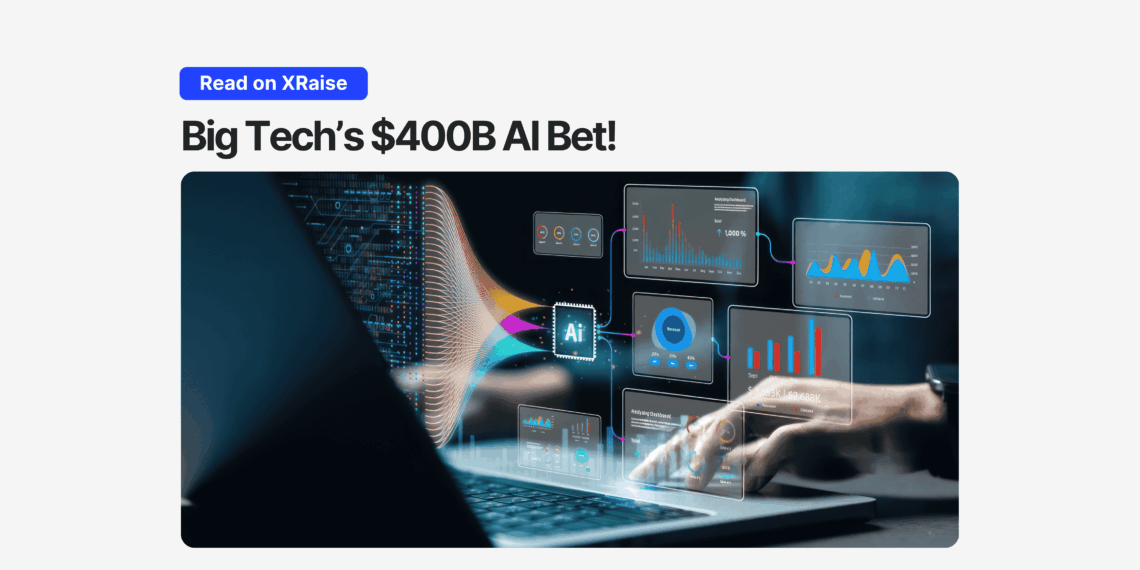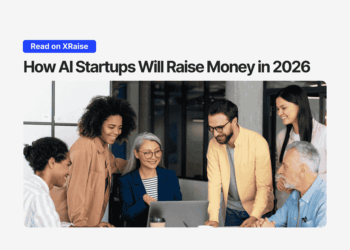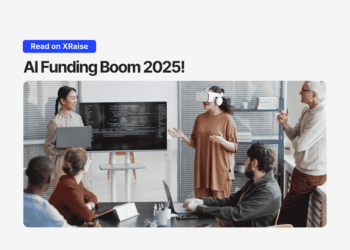Choosing where innovation ends and speculation begins has never been harder.
According to Reuters, Microsoft, Google, Amazon, and Meta are set to spend over $400 billion on AI infrastructure in 2025 a record-breaking leap in corporate tech investment.
From GPUs to proprietary chips, Big Tech is betting that the future of the internet runs on intelligent infrastructure. But as spending accelerates, returns remain uncertain, raising a critical question:
Is this real innovation or the start of the next AI investment bubble?
Big Tech’s $400B AI Investment Wave
This unprecedented AI spending is reshaping the global tech economy.
- Microsoft: $140B+ for Azure AI and OpenAI partnership
- Amazon: $100B+ for AWS Bedrock and custom Trainium chips
- Google: $90B for Gemini models and TPU clusters
- Meta: $70B for AI-driven ads and Llama training
Combined, these four firms will outspend the entire global semiconductor industry of 2020 in a single year.
While the spending expands capacity, it’s also inflating valuations far faster than adoption, classic symptoms of an AI investment bubble.
Only 5% of AI Projects Create Value
A recent MIT Sloan study warns:
“Only 5% of enterprise AI deployments achieve measurable business outcomes.”
The study cites three major causes fueling the AI bubble:
- Data fragmentation: Unclean, unstructured datasets limit scalability.
- Integration gaps: Models don’t connect to real workflows.
- Infrastructure obsession: Billions go into compute, not outcomes.
So while Big Tech builds the pipes, value creation lags. If markets tighten, that imbalance could pop the AI investment bubble.
Want to see how founders can stay resilient?
Explore accelerators focused on sustainable AI development →
Why the AI Investment Bubble Matters for Founders
The implications for startups are huge.
When innovation outpaces ROI, ecosystems polarize — a few giants dominate, while early-stage teams fight for traction.
We’ve seen this movie before:
- The dot-com bubble (1999–2001) overvalued “internet potential.”
- The crypto wave (2018–2022) scaled speculation faster than adoption.
AI is more foundational — it’s infrastructure. But the speed and concentration of capital demand founders who can separate hype from value.
The Big Tech AI Arms Race (2025 Estimates)
| Company | 2025 CapEx | Core Focus | Early ROI Indicators |
|---|---|---|---|
| Microsoft | ~$140B | Azure AI, OpenAI, Copilot | Moderate (Copilot, Bing AI) |
| Amazon | ~$100B | Bedrock, Trainium | Strong (enterprise AI hosting) |
| ~$90B | Gemini, TPU, Vertex AI | Moderate (cloud margins) | |
| Meta | ~$70B | Llama models, ad automation | Weak (early signs) |
Each is racing to control the next generation of compute, from chips to APIs.
For startups, this means rising costs, fewer open-source pathways, and the need to innovate around applied value, not scale.
Surviving the AI Investment Bubble
If you’re building in 2025, the message is clear:
Stop chasing hype. Start proving ROI.
Here’s how founders can stay grounded:
1️⃣ Focus on applied AI.
Build integrations that solve workflow problems and deliver measurable impact.
2️⃣ Leverage startup perks.
Reduce cloud and compute costs via exclusive startup perks and tech credits on XRaise.
3️⃣ Learn from specialized accelerators.
Programs like Lifted VC or Techstars AI teach sustainable growth models.
4️⃣ Track real adoption metrics.
Use tools like Mixpanel or Deepgram to measure impact instead of vanity metrics.
⚙️ Founders who use AI as a tool, not a badge will outlast the hype cycle.
Is the AI Gold Rush Sustainable?
The AI investment boom is draining power grids as fast as it builds models.
The IEA estimates global data-center power usage will double by 2027, and Nvidia still dominates over 80% of the GPU market.
Yet there’s nuance:
- These infrastructure investments will create long-term capacity startups can later access cheaply.
- The risk lies not in technology, but timing and valuation.
In short: The best founders will use Big Tech’s infrastructure wave to build leaner, smarter AI startups.
Founders’ Takeaway
- AI hype ≠ traction.
- Focus on measurable user outcomes.
- Use perks and tools that create ROI.
Platforms like Deepgram, Mixpanel, and OpenAI APIs drive value now, no speculation required.
If you’re mapping your 2026 roadmap, focus on AI that improves efficiency, not vanity metrics.
And if you want to stretch your runway while scaling smarter, check out the Startup Perks & Tech Credits available through XRaise.
Avoiding the AI Investment Bubble Trap
The $400B AI boom proves one thing: intelligence is the new infrastructure.
But for founders, the real goal isn’t to outspend Big Tech, it’s to outlearn them.
Stay lean. Stay data-driven. Build for ROI, not headlines.
And remember the best founders always see bubbles as timing signals, not barriers.
See the full breakdown of AI funding trends shaping this bubble
to understand where the next opportunities will emerge.
Explore More from XRaise
The $400B AI boom may redefine the tech landscape or expose the limits of overhyped innovation.
📊 Read next:
👉 AI Funding Boom 2025 – Opportunity or Overhype?
Want to build something real in this cycle?
Explore the latest Startup Perks & Tech Credits
to cut costs and scale efficiently.





